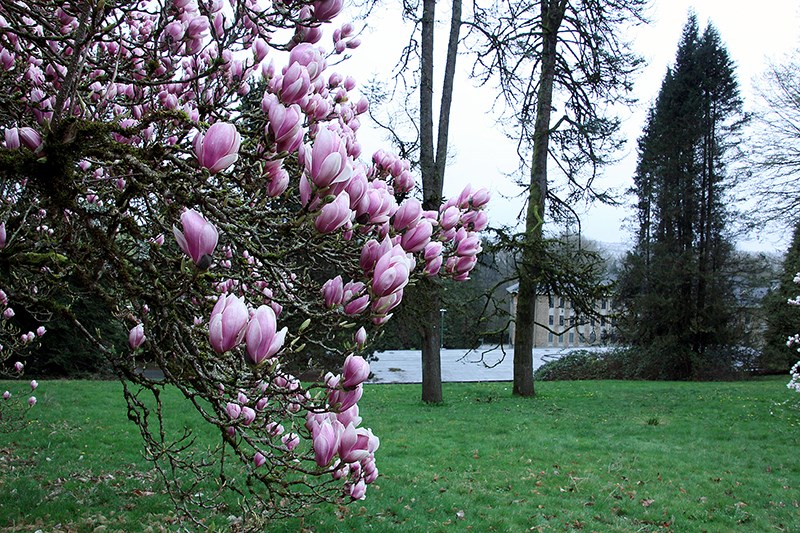With all the recent sunshine, spring is in the air. A sure sign of spring is the beginning of the tree tour season on the Riverview Hospital grounds. The first tree tour will take place this Sunday at 1 p.m. with tours continuing on Sundays once a month (schedule at www.rhcs.org).
This impressive collection of trees was initiated by John Davidson, the province’s first botanist, in 1911 before he moved to UBC to plan its botanical garden. Now comprised of more than 1,800 inventoried trees, the Riverview collection includes approximately 160 species representative of temperate zones around the world.
Sunday’s tree tour offers an opportunity to examine the architecture of deciduous tree species before they leaf out. Throughout the year, the conifers of Riverview provide a stately green backdrop to the site’s inspiring landscapes.
Coniferous forests are such a common feature on our coast it can be hard to comprehend what a rare group of trees conifers truly are. Back in the age of the dinosaurs, they were the predominant form of vegetation. The collision of our planet with a large meteor 66 million years ago brought the age of dinosaurs to an end and eliminated most coniferous species. The few that survived are now relicts from a distant past.
While there are more than 300,000 species of flowering plants, only 629 species of conifers still exist around the planet, with many found only in the southern hemisphere. Even among trees, flowering tree species are 50 times more abundant than coniferous species.
Conifers appear to have carved out a niche by growing in places not suitable for many deciduous trees — e.g., in the far north, at higher altitudes or on poorer soils. On the Pacific west coast, with plentiful winter rains and droughty summers, conifers have a competitive growing advantage over deciduous trees. Only tropical lowland rainforests are totally bereft of conifers.
All conifers have a woody structure whether they are lowly junipers hugging the ground or tall, majestic sequoias. Unlike deciduous trees, coniferous trees tend to share a similar architecture with a single main trunk and conical shape that allows sunlight to reach the lower branches.
Conifers are not only the tallest trees in the world, they are also famous for their longevity. Both the oldest and tallest conifers are found in California. There, a bristlecone pine has been aged at 4,600 years and a giant sequoia at 3,200. In Chile, a Patagonian cypress has found to be more than 3,600 years old and it is not at all uncommon for conifers to live a thousand years or more. On our coast, Douglas fir, western red-cedar and yellow cedar can all live well over a thousand years.
The tallest trees in the world are also conifers. The tallest, a coast redwood in California, measures more than 115 m in height while the tallest Douglas fir, Sitka spruce and giant sequoia are all over 90 m — that’s the equivalent of a 30-storey building.
Despite accounting for only 2% of existing tree species, conifers supply 45% of the world’s lumber and comprise the largest terrestrial carbon sink on the planet. Thus, conifers — these survivors from the age of dinosaurs — punch well above their weight when it comes to providing services to mankind.
The tree collection at Riverview includes more than 40 species of these majestic trees. These include magnificent specimens of coast redwood, giant sequoia, incense-cedar, dawn redwood and Douglas fir. Uncommon species of conifers at Riverview include the Japanese umbrella pine, the only survival member of its genus, and the beautiful sugi cedar, also from Japan. This is another long-lived tree with specimens found in Japan well over 2,000 years old.
As the age of conifers dimmed millions years ago, flowering trees began to emerge. The most primitive group of flowering trees is the beautiful magnolia family. These trees evolved long before the appearance of pollinating insects such as bees. Thus, their large and fleshy flowers were designed to attract the attention of beetles to provide this pollination service.
The month of March is also one of the best times to view some of the blooming magnolias at Riverview. Why not celebrate the arrival of spring with a stroll through Riverview’s spectacular trees?
--Elaine Golds is a Port Moody environmentalist who is conservation/education chair of the Burke Mountain Naturalists and member of the boards of the Colony Farm Park Association and the Port Moody Ecological Society.



